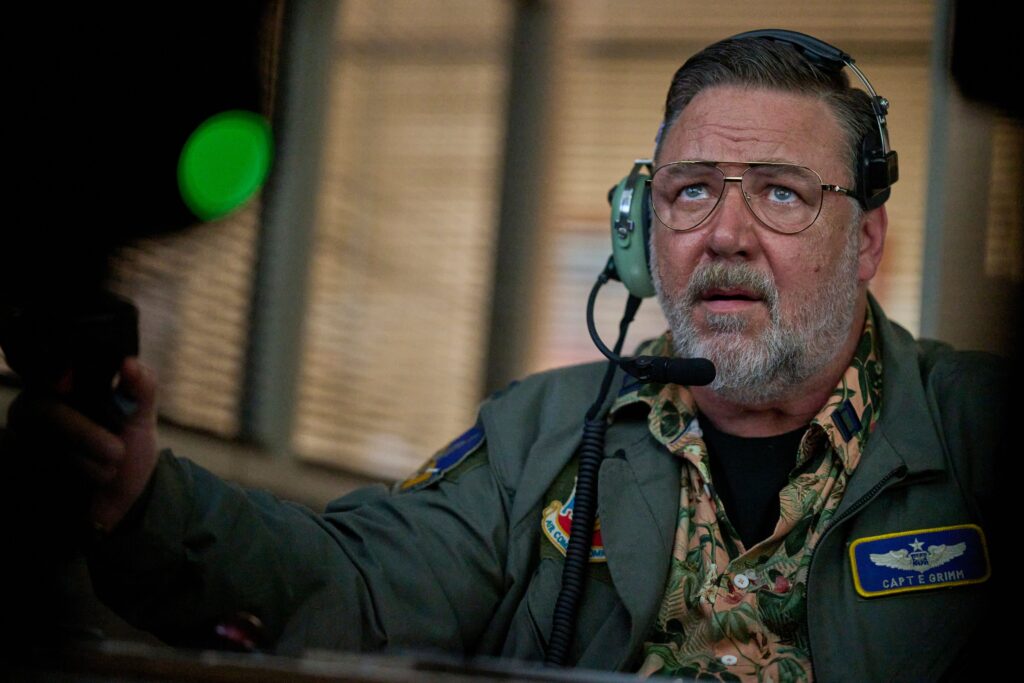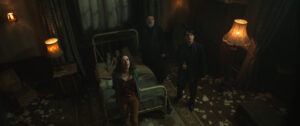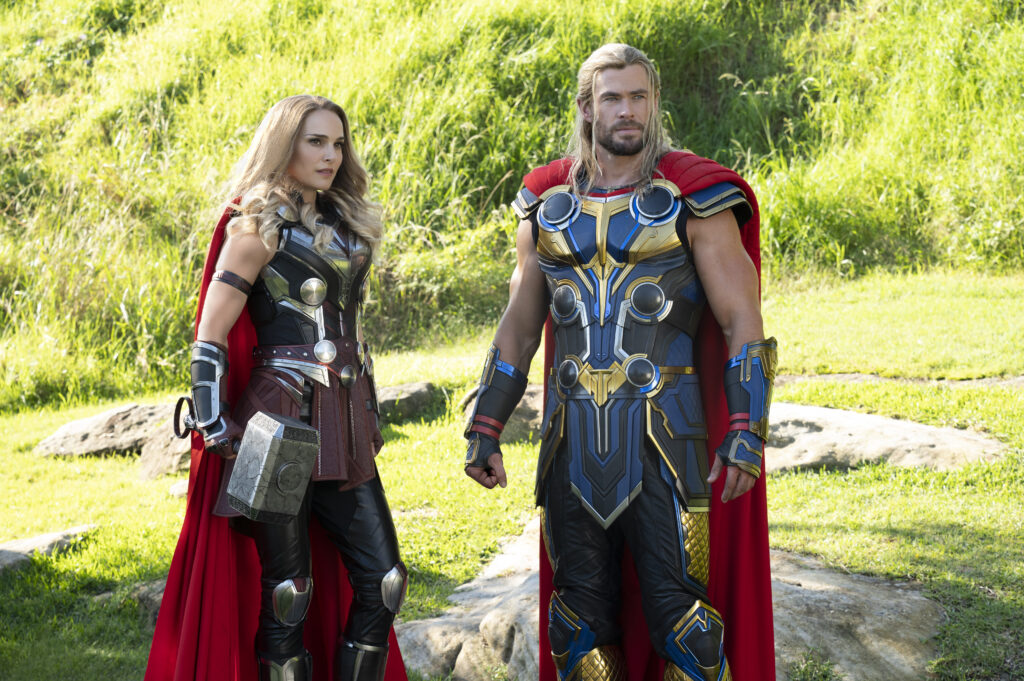February 21, 2024
by Carla Hay

Directed by William Eubank
Culture Representation: Taking place in Southern Asia, the action film “Land of Bad” features a predominantly white and Asian cast of characters (with a few African Americans and Latinos) portraying U.S. military people and Asian terrorists.
Culture Clash: A four-man Delta Force team (a special unit of the U.S. Army) gets attacked by terrorists in a South Asian jungle, and a drone pilot in a far-away control room must guide them out of their predicament.
Culture Audience: “Land of Bad” will appeal primarily to fans of the movie’s headliners and mindless military films.

“Land of Bad” should’ve been titled “Land of Bad Filmmaking.” This woefully inept military action flick wants viewers to believe that remote voices from a portable device cannot be drowned out by massive explosions. Russell Crowe’s career has also devolved into doing awkward comedy in terrible non-comedy movies. Much of the movie’s ludicrous action relies entirely on showing people running for their lives in a jungle with bombs or guns going off around them while still being able to chat on walkie-talkie audio levels with someone who can see everything on a drone video monitor in a far-away control room.
Directed by William Eubank, “Land of of Bad” was co-written by Eubank and David Frigerio. The movie is just one fake-looking scene after another, with juvenile dialogue that is just plain embarrassing if it’s supposed to represent the U.S. military. There are shallow video games that are better than this “Land of Bad” dreck.
“Land of Bad” has this captioned statement in the introduction: “Currently, the Sulu Sea is home to some of the most violent extremist groups in Southern Asia. Intelligence agencies from around the world work together in a global struggle where men and women put their lives on the line every day. We are in a war … we just don’t know it.”
First of all, there are no “intelligence agencies from around the world” working together in this movie. The only “heroes” and “rescuers” are from the U.S. military. It’s an example of shoddy screenwriting that this introductory statement doesn’t match what’s actually in the film.
Second, the movie has a running “joke” that most of the U.S. military people who are supposed to look out for the “people who put their lives on the line” in this story would rather watch a basketball game on TV and ignore potential emergency phone calls in their control center instead of doing their jobs. It’s pathetic.
“Land of Bad” begins by showing the four-man Delta Force squad that is being sent to an unnamed jungle area in Southern Asia, where they are on a vague mission to capture terrorists. (“Land of Bad” was actually filmed in Queensland, Australia.) And by the way, as the squad leader mentions in an offhand manner, a Joint Special Operations Command (JSOC) asset has been captured in this jungle, so if they have time, they might as well find him too. Too bad the filmmakers of “Land of Bad” didn’t take the time to make a good movie.
The four men in the squad are:
- JJ Kinney (played by Liam Hemsworth), a 27-year-old former U.S. Air Force sergeant, who is new to the U.S. Army because he left the Air Force due to “stomach problems,” he tells the other guys. Don’t expect further details.
- John “Sugar” Sweet (played by Milo Ventimiglia), a master staff sergeant, who is the no-nonsense squad leader.
- Sergeant Abell (played by Luke Hemsworth, an older brother of Liam Hemsworth in real life), a wisecracking jokester who doesn’t have a first name in the movie.
- Sergeant Bishop (played by Ricky Whittle), who is stern and judgmental and doesn’t have a first name in the movie.
Monitoring this operation in a control room on a military base is a cynical grouch named Eddie Grimm, nicknamed Reaper (played by Crowe)—as in, “grim reaper” (wink wink, nudge nudge)—a captain who is a drone operator watching their every move on video screens. If the squad finds the terrorist hideout that the U.S. military is looking for, there is a plan to launch a missile bomb at this hideout. At one point in the movie, Reaper mentions that he could’ve been a fighter pilot in the U.S. Air Force, but he mouthed off too much to his commanding officers, so his military career stalled.
Reaper still mouths off a lot, which is supposed to be the movie’s “comic relief,” but his jokes fall flatter than a military buzzcut. Here’s an example of one of the so-called jokes: Reaper complains to JJ that Reaper’s wife is a strict vegan. Reaper says to JJ, “How do you know someone is vegan?” JJ replies, “I don’t know.” Reaper says, “They will tell you.”
During the course of this ludicrous movie, because of all the self-absorbed yakking that Reaper does, viewers will hear more than they need to know about Reaper’s personal life and almost nothing about the squad members whose lives are in danger. Reaper has been married and divorced three times and is married to his fourth wife Lucy, who is pregnant and due to give birth at any moment. (Lucy is never seen in the movie.) The baby will be his ninth child. His eight other children are from his previous marriages.
Reaper has a loyal military sidekick named Nia Branson (played by Chika Ikogwe), a staff sergeant who is the only military woman in this movie. Nia has invited Reaper to her upcoming wedding. Later, when the mission becomes a life-and-death situation for the squad, Nia is by Reaper’s side in helping with drone video monitor duties.
This is JJ’s first Tier One (highly secretive) mission. Abell is friendly and welcoming to JJ. By contrast, Bishop gives JJ a hard time over JJ’s lack of experience in this type of work and is openly skeptical that JJ has what it takes to successfully complete the mission. And as soon as Bishop shows that he underestimates JJ, you just know who’s going to be the main “hero” of the story.
Bishop snarls at JJ: “Do me favor: Keep up. And don’t fuck up. The last thing we need in this ops is to save your ass.” For reasons that are never explained or shown, JJ has been given the nickname Playboy. However, in the beginning of the mission, JJ gets worried because he can’t find his mini-box of Fruit Loops cereal, so Bishop somewhat taunts JJ by calling him Fruit Loop instead of Playboy.
The four men parachute into the jungle. It isn’t long before they get in a shootout with terrorists who have beheaded some people. It’s enough to say that the squad members get separated, and not everyone in the squad makes it out alive. At least one of the squad members gets captured, and it’s up to the “hero” squad member to come to the rescue. This person manages to escape explosions and shootouts with hardly any wounds for most of the movie.
Meanwhile, back in the military base control room, most of the people on duty are watching a basketball game on a TV in the break room. The people who are watching the game include Colonel Duz Packett (played by Daniel MacPherson), who is hardly seen doing any real work. Reaper clashes with Duz (who is Reaper’s commanding officer) because Duz thinks Reaper is being too uptight for yelling at the guys in the room because they turned down the volume on the landline phone in the room. Duz says they need to be able to hear the phone in case his wife Lucy calls when she goes into labor. Later, there’s another big reason why the phone needs to be heard when someone calls.
“Land of Bad” has a very generic terrorist as the main villain. His name is Saeed Hashimi (played by Robert Rabiah), and he doesn’t have most of his scenes until the last third of the movie. That’s because “Land of Bad” spends a mind-numbing amount of time showing JJ by himself in the jungle. Reaper bonds with JJ over their remote chats when Reaper finds out that they’re both from cities that are only a few miles apart in Ohio. (Reaper is from Brook Park. JJ is from Middleburg Heights.) The only other tidbit of personal information that is revealed about JJ is that his father recently died.
When JJ is not dodging bullets and bombs, he’s hiding out in the jungle with potential captors nearby. Even when JJ is supposed to be hiding in silence, Reaper keeps yapping away on the remote communications device that JJ has. Somehow, Reaper’s voice can be heard by JJ during the loud explosions and gunshots (even though JJ is not wearing hearing devices), but then when Reaper talks during moments where JJ has to be quiet because enemies are close enough to find him, somehow these enemies can’t hear these voice sounds coming from JJ’s communications device. That tells you all you need to know about how stupid “Land of Bad” is and how stupid the movie expects viewers to be when watching this junk.
The Avenue released “Land of Bad” in U.S. cinemas on February 16, 2024.






